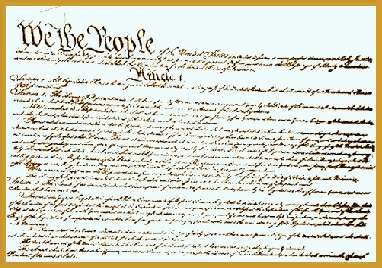|
PinkMonkey Study Guide - American History
3. 7 Articles of Confederation
The First Constitution
During the eight year long war with Britain, the
administration of the colonies fell into the hands of the Continental
Congress. Though the Congress worked efficiently during this critical
period, it was a provisional government. The members of the Congress
felt the need for a permanent governing body to manage the affairs
of the new nation.
Therefore, in July 1776, a committee was instituted
to formulate a plan and submit a proposal for a new government.
The chairman of the committee, John Dickinson, placed before the
Congress - a plan that caused a lot of controversy. The new government
was to have broad and sweeping powers like the right to establish
state boundaries, the right dispose off unoccupied land in the West
of North America. Besides these rights, each state (not withstanding
their size / population) was to have one vote in the Congress.
A Fragment of the American Constitution

Exhibit 3.5
A heated debate over the proposal, raged for almost
one and a half year while the war was on. Finally after dropping
the provision that gave governments the right to control lands in
the West, the Congress accepted the proposals. These modified proposals,
called the Articles of Confederation were adopted by the
Congress in November 1777 before it was sent to the individual states
for ratification.
Consequently, in 1781, the United States was
given her first constitution. The constitution stated that all
states were bound together in "a firm league of friendship"
and would give mutual support to each other, against any foreign
aggression. The Congress had the sole power over foreign affairs.
It had the right to take decisions on issues concerning war and
peace. There was great rejoicing and celebrations everywhere on
the ratification of the Articles. But there were a few short comings
in the new constitution. The new government did not have the right
to tax for revenues. Moreover, it could not regulate trade and commerce
both inside the country and abroad.
These shortcomings later affected the smooth functioning
of the new government. This was evident in the sphere of foreign
relations. Apart from the unstable currency, on which the Congress
had no control, it had no assured income. Also, it did not have
a standing army or a navy to command respect from the foreign powers
especially, from the Spanish and the English who had a fleet of
naval ships to protect their interests. While, relations with Britain
were strained, the government faced problems with Spain on the other
hand. In the southwest there was controversy over the Spanish boundary
and the use of the Mississippi river by the Americans for trade.
Due to the controversy over the boundary, Spain had closed the lower
part of the river to Americans traders. The American traders wanted
to use the river for mercantile activities. They wanted the right
to deposit their goods in New Orleans so that they could be shipped
by big vessels going abroad. Access to the river would help the
traders to sell their goods in the Louisiana market. John Jay tried
to reach an agreement with the Spanish on the boundary. But his
attempt failed in 1786, when the Congress refused to accept, the
agreement. This was because Jay agreed to closing the main river
of the United States. Such problems and other internal conflicts
- like the Shays Rebellion made several prominent members
like Alexander Hamilton to reconsider the Articles of Confederation.
Thus, in 1787, the Congress invited all the states to make amendments
to the articles. ( Shays Rebellion: War debts made many states
like Massachusetts tax its people heavily. But when farm prices
fell, it caused great distress to the farmers. They were forced
to sell the lands because of debts. In 1786, fifteen hundred farmers
of Hampshire country marched to the court of common pleas and prevented
it from meeting. After a few days later, 100 armed men at Worcester
prevented the Judge from entering the court. This Rebellion was
popularly called Shays Rebellion after Daniel Shay, the leader of
the rebels.)
[Next Page]
|
Table of Contents
3.0
- Chronology of Major Events in this Period
3.1 - Causes
3.2 - The Events Leading tothe
war of Independence
3.3 - The First Continental Congress
3.4 - The declaration of Independence
3.5 - The Course of the War
3.6 - War and Peace
3.7 - Articles ofConfederation
3.8 - The Formation and
Ratification of the Constitution
3.9 - Points to Remember
Chapter 4
|